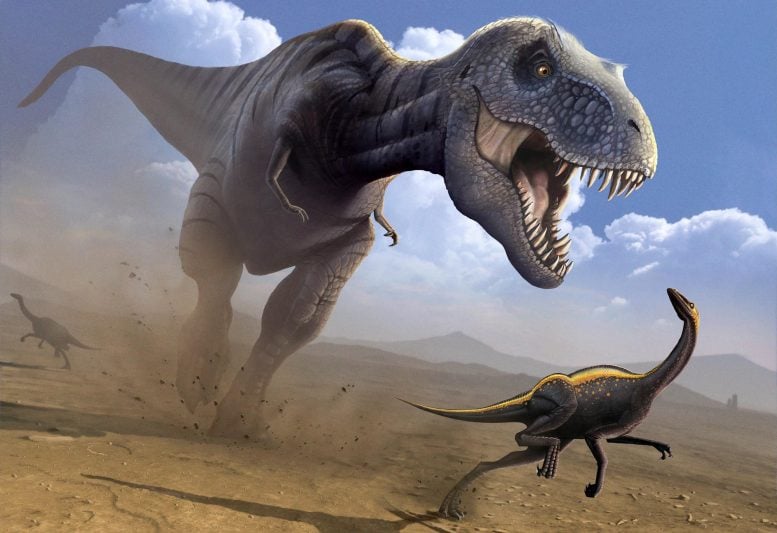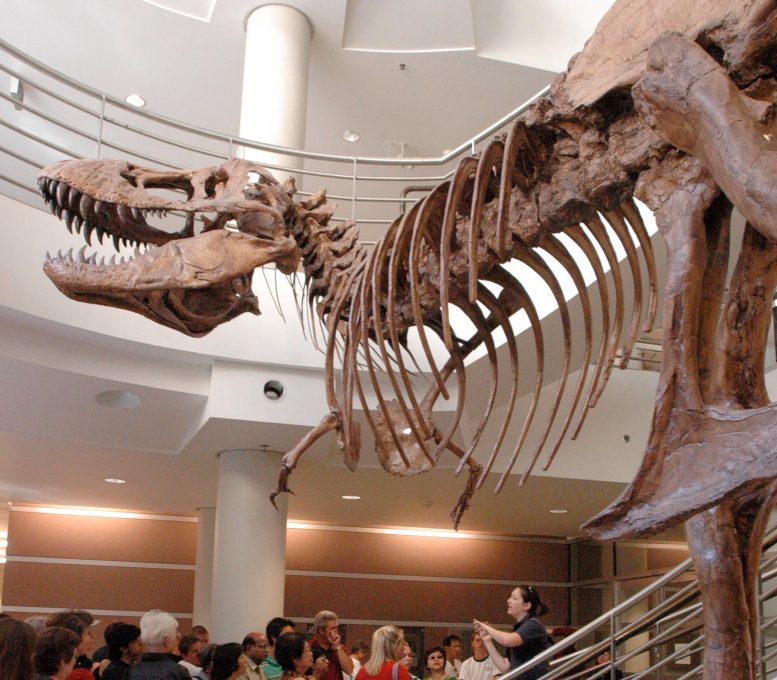
Paleontologist Kevin Padian, Emeritus Professor of Integrative Biology at the University of California, Berkeley, and curator at the UC Museum of Paleontology, has proposed a new hypothesis regarding the remarkably short arms of the Tyrannosaurus rex. In a paper published in Acta Palaeontologia Polonica, Padian suggests the T. rex’s arms may have shrank in size to prevent accidental or intentional amputation during communal feeding. He notes that severe bite wounds can cause infection, hemorrhage, shock, and death.
T. rex’s short arms may have lowered risk of bites during feeding frenzies.
A new hypothesis suggests that the T. rex’s short arms may have evolved to avoid injury during communal feeding, particularly to prevent accidental or intentional amputation caused by the creature’s powerful jaws and teeth.
Over the two decades paleontologist Kevin Padian taught a freshman seminar called The Age of Dinosaurs, one question asked frequently by undergraduates stuck with him: Why are the arms of Tyrannosaurus rex so ridiculously short?
He would usually list a range of paleontologists’ proposed hypotheses — for mating, for holding or stabbing prey, for tipping over a Triceratops — but his students, usually staring a lifesize replica in the face, remained dubious. Padian’s usual answer was, “No one knows.” But he also suspected that scholars who had proposed a solution to the conundrum came at it from the wrong perspective.
Rather than asking what the T. rex’s short arms evolved to do, Padian said, the question should be what benefit those arms were for the whole animal.
In a new paper appearing in the current issue of the journal Acta Palaeontologia Polonica, Padian floats a new hypothesis: The T. rex’s arms shrank in length to prevent accidental or intentional amputation when a pack of T. rexes descended on a carcass with their massive heads and bone-crushing teeth. A 45-foot-long (14-meter-long) T. rex, for example, might have had a 5-foot-long (1.5-meter-long) skull, but arms only 3 feet (0.9 meters) long — the equivalent of a 6-foot human with 5-inch arms.

A lifesize cast of T. rex in the atrium of UC Berkeley’s Valley Life Sciences Building shows how peculiarly short the forearms were, given that the creature was the most ferocious predator of its day. Credit: Photo by Peg Skorpinski
“What if several adult tyrannosaurs converged on a carcass? You have a bunch of massive skulls, with incredibly powerful jaws and teeth, ripping and chomping down flesh and bone right next to you. What if your friend there thinks you’re getting a little too close? They might warn you away by severing your arm,” said Padian, distinguished emeritus professor of integrative biology at the University of California, Berkeley, and a curator at the UC Museum of Paleontology (UCMP). “So, it could be a benefit to reduce the forelimbs, since you’re not using them in predation anyway.”
Severe bite wounds can cause infection, hemorrhaging, shock, and eventual death, he said.
Padian noted that the predecessors of tyrannosaurids had longer arms, so there must have been a reason that they became reduced in both size and joint mobility. This would have affected not only T. rex, which lived in North America at the end of the Cretaceous period, he said, but the African and South American abelisaurids from the mid-Cretaceous and the carcharodontosaurids, which ranged across Europe and Asia in the Early and Mid-Cretaceous periods and were even bigger than T. rex.
“All of the ideas that have been put forward about this are either untested or impossible because they can’t work,” Padian said. “And none of the hypotheses explain why the arms would get smaller — the best they could do is explain why they would maintain the small size. And in every case, all of the proposed functions would have been much more effective if the arms had not been reduced.”
He admitted that any hypothesis, including his, will be hard to substantiate 66 million years after the last T. rex became extinct.
Arms and the T. rex
When the great dinosaur hunter Barnum Brown discovered the first T. rex fossils in 1900, he thought the arms were too small to be part of the skeleton. His colleague, Henry Fairfield Osborn, who described and named T. rex, hypothesized that the short arms might have been “pectoral claspers” — limbs that hold the female in place during copulation. This is analogous to some sharks and rays’ pelvic claspers, which are modified fins. But Osborn provided no evidence, and Padian noted that the T. rex’s arms are too short to go around another T. rex and certainly too weak to exert any control over a mate.
Over more than a century, other proposed explanations for the short arms included waving for mate attraction or social signaling, serving as an anchor to allow T. rex to get up from the ground, holding down prey, stabbing enemies, and even pushing over a sleeping Triceratops at night. Think cow-tipping, Padian said. And some paleontologists propose that the arms had no function at all, so we shouldn’t be concerned with them.
Padian approached the question from a different perspective, asking what benefit shorter arms might have for the animal’s survival. The answer came to him after other paleontologists unearthed evidence that some tyrannosaurids hunted in packs, not singly, as depicted in many paintings and dioramas.
“Several important quarry sites unearthed in the past 20 years preserve adult and juvenile tyrannosaurs together,” he said. “We can’t really assume that they lived together or even died together. We only know that they were buried together. But when you find several sites with the same animals, that’s a stronger signal. And the possibility, which other researchers have already raised, is that they were hunting in groups.”
Perhaps, he thought, the arms shrank to get out of the way during pack feeding. T. rex youngsters, in particular, would have been wise to wait until the larger adults were finished.
In his new paper, Padian examines speculations by other paleontologists, none of which appear to have been fully tested. The first thing he determined, by measuring the lifesize T. rex cast that dominates the atrium outside the doors of the UCMP, is that none of the hypotheses would actually work.
“The arms are simply too short,” he said. “They can’t touch each other, they can’t reach the mouth, and their mobility is so limited that they can’t stretch very far, either forward or upward. The enormous head and neck are way out in front of them and pretty much form the kind of death machine you saw in ‘Jurassic Park.’”
Twenty years ago, two paleontologists analyzed the arms and hypothesized that T. rex could have bench pressed about 400 pounds (180 kilograms) with its arms. “But the thing is, it can’t get close enough to anything to pick it up,” Padian said.
Beware of Komodo dragons
Padian’s hypothesis has analogies in some fearsome animals today. The giant Komodo Dragon lizard (Varanus komodoensis) of Indonesia hunts in groups, and when it kills prey, the larger dragons converge on the carcass and leave the remains for the smaller ones. Maulings can occur, as they do among crocodiles during feeding. The same could be true of T. rex and other tyrannosaurids, which first appeared in the Late Jurassic and reached their peak in the Late Cretaceous before becoming extinct.
Firmly establishing the hypothesis may never be possible, Padian said, but a correlation could be found if museum specimens around the world were checked for bite marks. That would be quite a feat of fossil crowdsourcing, he admitted.
“Bite wounds on the skull and other parts of the skeleton are well known in tyrannosaurs and other carnivorous dinosaurs,” he said. “If fewer bite marks were found on the reduced limbs, it could be a sign that reduction worked.”
But Padian has no illusion that his idea will be the end of the story.
“What I first wanted to do was to establish that the prevailing functional ideas simply don’t work,” he said. “That gets us back to square one. Then, we can take an integrative approach, thinking about social organization, feeding behavior, and ecological factors apart from purely mechanical considerations.”
One problem in establishing the hypothesis is that there were several groups of large carnivorous dinosaurs that independently reduced their forelimbs, although in different ways.
“The sizes and proportions of the limb bones in these groups are different, but so are other aspects of their skeletons,” Padian said. “We shouldn’t expect them to be reduced in the same way. This is also true for the reduced wings of our large, living, flightless ratite birds, like the ostrich, the emu, and the rhea. They evidently took different evolutionary paths for their own reasons.”
Padian sees a common thread in the history of explanations of short arms and other characteristics of T. rex.
“To me, this study of what the arms did is interesting because of how we tell stories in science and what qualifies as an explanation,” he said. “We tell a lot of stories like this about possible functions of T. rex because it’s an interesting problem. But are we really looking at the problem the right way?”
Reference: “Why tyrannosaurid forelimbs were so short: An integrative hypothesis” by Kevin Padian, 30 March 2022, Acta Palaeontologica Polonica.
DOI: 10.4202/app.00921.2021
Padian’s paper is part of a Festschift honoring mammalian paleontologist Richard Cifelli, long-time head of the Oklahoma Museum of Natural History and Presidential Professor of Biology at the University of Oklahoma in Norman.









Problem with badit scientist they will not accept dinosaur as a gator .thecodont is a dinosaur thecodont mean crocodilian teeth .the evidence is clear dinosaur is the primitive ancestor of the gator.why is the gator pectoral girdle like a bird a flying feature .gator clearly could not fly advance pectoral girdle like bird and dinosaur furcula is rare in the animal world .early reptile did have pectoral girdle like a gator it is only found in dinosaur now .today dinosaur the gator is very fast very dangerous animal so there ancestor was the same because they are same animal gator and dinosaur is the same animal that answer for there behaver and science .t.rex was head killing predator dinosaur like the gator .t.rex was not grasping predator .tetanuran gator is like that too . Most predator dinosaur were grasping predator .when dinosaur become head killing dinosaur the finger change middle finger same size as grasping thumb some time the thumb is smaller than the middle finger like that 4 finger predator dinosaur they claim reduce finger that this dinosaur is turn into bird because bird lost there first finger and toe .reason why for diverse finger is speed .predator dinosaur was a quadrupedal predator it’s true theropod was a poor quadrupedal .theropod are design for land they can not sprawl there ankle are fuse gator ankle are not fuse and there femur does not have a peg only birds theropod maybe humans have peg femur.the finger only could use for launching one step not like normal quadrupedal animal . the finger was use to launch bipedal fast .early predator theropod dinosaur has robust arms it’ is not like birds arms or maniraptoran birds arm .it Show advance pectoral girdle is for speed they were fast like there descendants the gator then predator dinosaur develope the furcula so there arm will not break like birds there is a lot of stress on bird arms you need powerful arms to fly the furcula is there to support so arm will not break that what it is use in dinosaur because they were fast animal .gator only have one furcula bone you need 2 bone and must be fuse to become a furcula .gator mostly quadrupedal animal it is bipedal like theropod and can be fully bipedal if it want to .most quadrupedal animal get rid of furcula bone .advance pectoral girdle of gator is use like dinosaur and bird furcula so arm would not break by running too fast .the gator is design for speed it has advance vertebrae the backbone like cats they have monster centra vertebrae joints this design is very rare in animal the cat has better design with disc joint it is lighter .these animal are so fast they can break the backbone and die in hunting that why they must have these hightech joint .that why gator has advance pectoral girdle so arms will not break .cat gator get there speed by the vertebrae not the legs.all head killing dinosaur there finger change.carnotaurus compsognathus t.rex and 4 finger dinosaur with small thumb and t.rex.t.rex carnotaurus finger are simular by convergent evolution .carnotaurus finger are fuse and look like they have 2 finger like t.rex they were fast quadrupedal .carnotaurus finger are like up right lizard with a mammal gait .that lizard change skin color a lot.this Show head killing dinosaur did use there arms but it’s not for grasping it’s for quadrupedal .grasping dinosaur could not change there finger because it use for grasping the prey a primitive feature that why there finger look the same.the finger change because dinosaur had a crouching attack like most modern predator . Thumb of gator is reduce simular to other quadrupedal animal but they still has big thumb claws like grasping predator theropod dinosaur which is very strange it is easyest dinosaur feature to see on a gator.some of head killing dinosaur the claws are not sharp which show they did not grasp there prey .the finger of t.rex show it was a very fast animal support by femur cartilage .
The T Rex was a egg layer like birds and made their nests out of mud . Their eggs were small and the hatchlings were born small and grew fast . When the T Rex sat on the mud nest to lay their eggs the short arms were used to keep the eggs in the mud nest and latter the hatchlings in the nest until they grew large enough to fend for themselves . These mud nests containing the fossil eggs have been found in China . I have some of these dinosaur eggs in my private dinosaur collection with fossil feathers in clay found in Liaoning China .
The arms are claspers for mating.
How much could those little twigs help holding down a 6 ton animal?
Dinosaur is a primitive master of speed gator is champ of speed the king of the dinosaur evolution is fill with fail advancement.crocodile wings is a fail speed advancement probaly only use it to jump out of water to catch prey fast like how theropod use there arm quadrupedal launch bipedal fast the force were so violent they have to have a robust arm and furcula .gator a advance modern crocodilian does not have wings.speed is the game in the king of the dinosaur the modern crocodilian .gator is a technology marvel respect the champ gator killing lion on YouTube who is real king of the beast .gator is design to battle tiger and lion that why it is last living dinosaur the last living spinosauridae the last living tyrannosaur .not all dinosaur died in a death roll .some mesoeucrocodylia eat plant too.bite force is important in eating plant .and small crocodilian is a well known pess eating the food of bigger crocodilian.if t.rex type predator dinosaur did not use there arm it will have 3 finger now it will probaly would not have shrank .carnotaurus does not have claws the elbow is fuse clearly use the arm as quadrupedal if arms is useless it will have normal grasping arm and elbow they evolve for speed.
It’s an interesting idea, but the reasoning presented both to dismiss other explanations and to justify this may be implausible. These notions are based on trying to imagine functions from an animal no human has ever seen alive with (entirely) properly-arranged bones and functional muscles and everything else that goes along with a living animal. Padian may be on the right track, but overthinking it in regards to specific function.
Let’s ask if dinosaur limb sizes and the Late Cretaceous climate changes correlate, and if so what that correlation is. Then, do Bergmann’s and Allen’s rules apply if there is a correlation? A higher priority should be on recovering and restoring DNA to study (as well as improving existing techniques for doing so), to look for evidence parallel changes in genes caused by common factors such as climate.
Are there any transition fossils to support this? They certainly would have evolved shorter arms over a period of time, so there should be at least some fossil evidence of longer arms in older members of the species or ancestral species.
I am surprised that there is no discussion of the obvious BIPED mobility of this Dinasaur, and what evolutionary advantage being a huge biped carnivorous animal might provide? Having the front limbs drastically reduced in size is obviously a transformation of a quadrupid into a biped creature. But I do not know enough to argue that that makes the animal a more efficiant predator.
Perhaps short t Rex arms were used for Egg & Young Care
If they had arms the same size as the rest of their body, they would have issues balancing as a bipedal animal. If they had the longer arms they would try to use them to run which would end up being slower than just not using them at all.